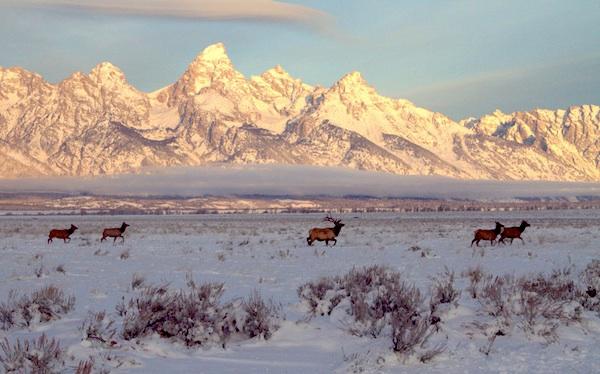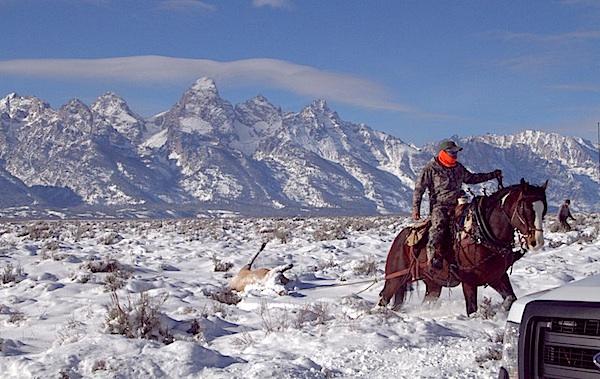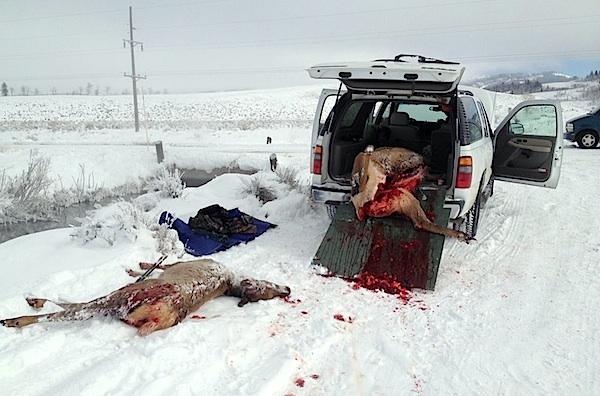
Elk fleeing the hunters/Bernie Scates
In the moments before dawn was to erupt on the landscape, I made out some shapes moving in the sagebrush close to the road. Fearing the possibility of hitting an animal, I slowed down and took a closer look.
Before me were 75 to 100 head of elk with a couple of beautiful bulls in the mix. I pulled over and stopped to watch the animals, mesmerized by their proud beauty and the dawning of a new day in gorgeous Grand Teton National Park. Instead of continuing to my destination at Schwabacher's Landing to photograph the sunrise, I decided to stay and watch the elk, hoping to capture them bathed in the red glow of early morning light.
One thing I will never forget about that November morning in 2013 was the smile on my face and the delight in my heart. That is until I looked into my rearview mirror and terror tore away at my being. I had forgotten about the yearly elk reduction hunt that takes place in Grand Teton every fall.
Hunters were running around their trucks, grabbing orange vests and rifles before tearing off after the elk, all before sunrise. The sun was just about to come up and I had been waiting for about 15 minutes when the hunters arrived. In my mind, I saw myself pointing the camera at the elk, only to have one collapse to the ground in front of me.
I could not bear the thought of watching an animal be killed by a hunter in our national park, and so did not pick up the camera. Panic kicked in. My thoughts were on people driving into the beautiful folds of the Tetons and being greeted by the crack of rifles, blood and corpses, right next to the highway. All of which would have been illegal, but I did not know that then.
And so I did what any indignant, righteous, law ignorant person would do. I started honking my horn. At the time I did not know that it was illegal to interfere with a hunt, which does not make sense to me. What about my rights to not have my photography efforts interfered with? It was clear that elk would be killed, but I was determined that the hunters would have to get off of the road and work for them, and so the honking continued. As it turns out, by law they have to be a quarter-mile off of Highway 89 before shooting an animal, which would have been impossible in that area.
The hunters picked up their pace, gesturing to me as they went. Unable to bear the thought of watching an elk, the beautiful bull in particular, go down, I left. Since then I have learned that only cows and calves can legally be killed in Grand Teton not bulls.
North America's Largest Elk Herd
The Greater Yellowstone Ecosystem, covering about 20 million acres from Grand Teton north through Yellowstone National Park, is home to the largest elk herd in North America, the Jackson elk herd. According to a publication on the park website, "Elk Ecology and Management," there are tens of thousands of elk in this herd and, "Management of the herd is challenging and involves a reduction program in the form of an annual harvest."
Don't you just love that word, "harvest," to describe the killing of wildlife? The use of that word alone tells me that local, state, and federal governments are trying to soften the blows of reality. Not that I am against hunting for food. But hunting in a national park, that does offend me, because I did not spend money for gas, food and a motel room to visit Grand Teton and watch animals be killed by hunters.

Hauling out a kill/Bernie Scates
In 1950, when the boundaries of Grand Teton were expanded, Congress approved a bill that would allow the hunting of elk in the park as a means of population management, "when necessary." From what I can tell, it has been necessary to hunt elk every year for 64 years, despite the wolf and grizzly populations that have supposedly rebounded to numbers large enough to justify the delisting of both species. Wolves prey on elk year-round, while grizzlies kill many newborn elk calves, as well as steal carcasses from wolves.
Despite the large number of elk in the Jackson elk herd that necessitates the annual "elk reduction hunt," elk are fed in winter on the National Elk Refuge that borders the park on the south to ensure their survival.
To further confuse the complex issues that surround the Jackson elk herd and the hunt inside of Grand Teton, in 2012 the herd was said to be about 11,050 animals - just 50 above the target range of 11,000 elk. Begging an answer to the question, if this hunt is about elk management and has nothing to do with man's heritage and a right to hunt elk in a national park, why does the hunt continue when the animal surplus is/was only 50?
I was horrified by the hunt last year, and did my best to avoid the area where the hunters were. Hearing gun fire and watching wildlife fall before my eyes is not why I visit national parks - I, personally visit them because that is where the animals should be safe. And, where wildlife watchers and photographers should be able to enjoy nature while feeling safe ourselves.
Grand Teton's website recommends that hikers in the park wear an orange vest during the hunt, which is something I purchased several years before during my first fall season in the park. But, ultimately it frightened me too much to hike where bullets were flying, and so the vest has never been used.
I believe that the decision to not hike during the hunt was a wise choice, after personal and newspaper reports recounted a elk reduction hunt horror story last week. A well-publicized photograph by Tom Mangelsen showed hunters lined up along the road last Wednesday, rifles ready for an elk massacre. (Click to see Mangelsen's photo and the original story of this event in the Jackson Hole News and Guide.)
Bernie Scates, a Jackson resident and full-time wildlife photographer whose photos are published with this article, stated that a number of hunters were lined up along the road surrounding the area of Kelly, waiting for elk to be herded out of the safe zone, back to the legal hunting area. Scates said that the elk were surrounded by hunters who opened fire and kept shooting until numerous elk were dead, including a couple of spike bulls.
'Hunting in a national park the way it is done in Grand Teton National Park involves herding the elk into the open flats with hunters lining the inner road and firing into the herd hoping to hit them,' Scates said. 'This way there are some elk that are illegally killed, like bulls and spikes, and some that are wounded and never taken care of.'
According to Scates, not only are the laws of the hunt ignored and animals are left to suffer, but he also said visitors are affected. 'Tourists and locals that come into the park hear continuing gun shots and it feels like they could be hit at any moment," he said. "Houses in the Antelope Flats area have many bullet holes in them. Also everywhere people go in the park, that is open in the south area, they witness dead elk being dragged out of the open sage areas onto the road, leaving gut piles and blood everywhere.'
According to Scates and a follow-up article in the Jackson Hole News & Guide, a number of hunters were cited for various offenses.

Elk harvest/Bernie Scates.
Harvesting Vs. Natural Control
Scates is concerned that when the facts are added up, the elk reduction hunt is about money, not wildlife management. 'Why would they continue feeding the elk on the refuge if their numbers are unmanageable?" he asks. "Why not discontinue the feeding program and let nature take its course?"
Another problem that has arisen out of the elk reduction hunt is the possibility that the park's grizzlies are becoming dependent on the hunt.
'The grizzly bears have become dependent on the gut piles for food before going into hibernation,' Scates believes. 'That means that the cubs growing up will not know another way to get their food and could starve - even now in hunting season the bears don't bother to hunt for themselves.'
Scates makes several good points. Why feed the elk if there are so many that a reduction hunt is necessary inside of Grand Teton National Park? It would appear that by feeding the elk, the powers that be are creating the need for the hunt. Also, why doesn't Wyoming create a safe zone for predators around the Greater Yellowstone Ecosystem so that the wolves and grizzlies can manage the elk populations? It would seem like a hunt inside of national park would be a last resort option, not a first line of defense.
Personally, I am offended by the ethics of hunters who would line the road and wait for animals to be herded towards them. Or, who would run out to shoot elk while park visitors are admiring the animals. And, it bothers me that myself or anyone else would pay good money to visit Grand Teton for the magnificent sights that it offers and to see wild animals, only to be confronted by blood, guts, and rifle shots. Will the hunt end when an unsuspecting park visitor is accidentally shot and killed?
The state of Wyoming, members of Congress, Grand Teton National Park officials have a lot of questions that they need to answer, openly and honestly.
Thank you to Bernie Scates for his contribution of photos and an interview for this month's column. Both Bernie and I felt like this is a story that needs to be told time and time again. To see more of Bernie's work, please visit his Facebook page:



Comments
I think it's necessary to seperate the issues here. Is the hunt currently legal. Yes. Is there anything wrong with hunters participating in a legal hunt? No. As long as hunters follow the rules, rants about slaughtering elk and unethical hunters are just examples of people (probably anti-hunters at heart) shouting that their values are different than those of the hunters. It's OK for me to take photographs from the road, but it's wrong for you to hunt where I can see it from the road. National Parks aren't for hunting because I say so. It does not make a lick of sense to have elk feedlots to sustain high numbers of elk, then turn around and hunt elk in GTNP to reduce the population, but which agencies are responsible for those policies? Rage at them, not hunters.
There are two issues here - should there be hunting in Grand Teton National Park? I say no when there are other, more natural methods to manage the high numbers of elk. At one point the grizzlies and wolves were taking 90% of the elk calves in Willow Flats. While the grizzlies still frequent that area, I believe that those particular wolves no longer do, or no longer exist. Also, the issue of feeding the elk and then stating that there needs to be an elk reduction hunt makes me think that the feeding is not for the elk at all but so there are elk for the hunters to hunt. I thought that one of the major goals of the national parks was to let nature be nature.
Secondly, there was the behavior of the hunters last week. The law says that they have to be 30' off of the road but they were clearly on the road. They are only allowed to shoot one round at fleeing elk but they kept shooting. They are only allowed to posses either 6 or 8 rounds while hunting. They are not allowed to harrass the animals and herd them into a zone where they can be shot. They are not allowed to kill bulls. And, geez, if they had the elk surrounded and just started firing, it is amazing that no one was hit. These hunters violated several laws and none of what they did deserves any respect.
This is not an anti-hunter story, but is it right to hunt in our national parks? And, is it really necessary?
Another consideration:
Lead in ammunition contaminates game meat
http://www.wildlifemanagementinstitute.org/index.php?option=com_content&...
http://www.sciencedaily.com/releases/2010/05/100531082601.htm
http://www.fieldandstream.com/blogs/ammunition/2010/06/more-scary-news-a...
http://www.nps.gov/pinn/naturescience/leadinfo.htm
Some hunters are also poachers and will violate any law to kill trophy animals.
These "hunters" clearly broke the rules. So, I have no problem directing a portion of my rage at them.
(As my father-in-law said (after he came in from deer hunting today, and learned about this incident): "these guys should go to jail.")
m13cli, it's a good argument against using lead ammunition. I think many probably feel the little bit of potentialy contaminated meat wont do them much harm and non lead ammunition is becomming much more popular and required in some types of hunting. Yes there will always be poachers even if hunting were outlawed altogether. That is unfortunate.
@ Deby. Do they have a right to hunt in the national parks? Since that is the law I would say yes. Do they need to, or is it necessary? Of course not, but then you and I don't need to take pictures either. As far as more natural ways to manage the elk or the place/purpose of national parks. We could just let nature take its course but we often find that is not a pretty sight either and wildlife biologists in particular seem to feel the need to tinker with what they think the right balance should be. And what is natural? I think man has been hunting as long as we have been on this planet so isn’t that natural? An argument could be made that building roads and visitor centers is more disruptive and less natural than a few hunters. There is no excuse for the illeagal actions described but again they don't represent the ethics of most hunters.
Wild Places, I think if they are going to allow hunting in National Parks, then it should be by using your bare hands. No bullets from guns, no sharp spears, no knives. Just bare knuckle brawl that large alpha bull elk down, like a bear or pack of wolves would do. In fact, it would have been great entertaining photos to see a pack of humans attempting to bring the elk down in such a manner. Deby could have got some great photos. And I don't disagree with you on roads. Tear em' up and let nature reclaim that surface too.